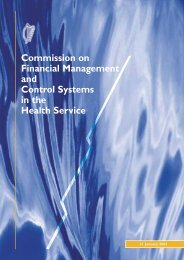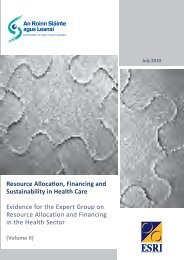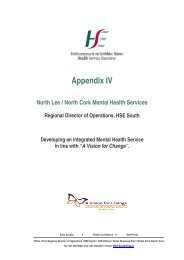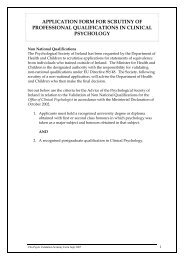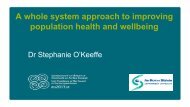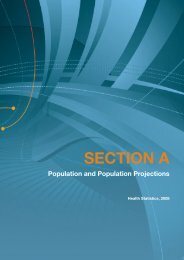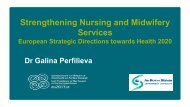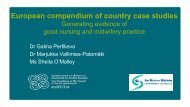All Ireland Traveller Health Study Our Geels - Department of Health ...
All Ireland Traveller Health Study Our Geels - Department of Health ...
All Ireland Traveller Health Study Our Geels - Department of Health ...
You also want an ePaper? Increase the reach of your titles
YUMPU automatically turns print PDFs into web optimized ePapers that Google loves.
<strong>Health</strong> Survey Findings<br />
the classification used by the Irish CSO, where SC 5 or 6 means that the present or last occupation <strong>of</strong><br />
the person is in either the semi-skilled or non-skilled occupational categories) or medical card users.<br />
It is acknowledged that the <strong>Traveller</strong> community is not homogeneous, and that as a distinct minority<br />
community it has characteristics that set it apart from the general Irish public in significant respects.<br />
Nonetheless because social inequality is one possible contributory feature to the health status <strong>of</strong> its<br />
population it is appropriate to control or adjust for that possibility ins<strong>of</strong>ar as possible.<br />
Description <strong>of</strong> the Data Sources Accessed<br />
Lifeways is a cross-generational cohort study <strong>of</strong> 1,000 Irish families funded by the <strong>Health</strong> Research<br />
Board, in which data was collected from family members including mothers, fathers, grandparents and<br />
children (O’Mahony et al., 2007). Two subsets <strong>of</strong> the Lifeways population were used to obtain the data<br />
for this comparison. Firstly, a dataset was created using baseline survey data from all adults in the study<br />
(mothers, fathers and grandparents, n=2,158 persons). Of this adult dataset, 510 persons had a medical<br />
card, and were therefore included in the analyses. For the second dataset, data were taken from the<br />
5-year follow up child examination from Lifeways, affording direct comparison to 5-year-old <strong>Traveller</strong><br />
children. These questions focused on the index child, with whom the mother was pregnant at the<br />
Lifeways cohort inception. There were follow up data on 68% <strong>of</strong> children, <strong>of</strong> whom 199 had mothers<br />
who had reported having a medical card at baseline. Despite the fact that Lifeways recruitment focused<br />
on pregnant women, subsequent studies have shown that the Lifeways cohort can be used as a<br />
representative sample <strong>of</strong> the general Irish population (Niedhammer et al., 2009).<br />
INSIGHT ‘07 is a study <strong>of</strong> consumer satisfaction with health and social care services. Data were collected<br />
by means <strong>of</strong> a survey <strong>of</strong> a nationally representative sample <strong>of</strong> Irish adults identified through the 2002<br />
census, with supplemental sampling <strong>of</strong> the over 50 age group. The final sample was 3,517 respondents,<br />
<strong>of</strong> whom 1,282 had medical cards. SLAN 2002 is a population-based survey <strong>of</strong> Irish adults. These data<br />
have been received through the Irish Social Science Data Archive (ISSDA). SLAN 2002 gathered data on<br />
5,992 participants, 1,645 <strong>of</strong> whom held medical cards. For this analysis, the data relating to persons who<br />
held medical cards were retained. SLAN 2007 is a population based survey <strong>of</strong> adults aged 18 and over,<br />
living in private accommodation, identified through the GeoDirectory. The SLAN 2007 raw data relating<br />
to medical card holders (n=3,445) has been made available to us through Dr Karen Morgan <strong>of</strong> RCSI.<br />
Results from SLAN 2007 were also gathered from the published reports, and in this case, comparisons<br />
with the AITHS group were made with published results relating to SC 5 and 6. Of the SLAN studies,<br />
SLAN 2007 comparisons were preferentially included as the most current data, although comparisons<br />
with SLAN 2002 were included if the equivalent data item was not available in SLAN 2007.<br />
The HBSC study 2006 is an EU linked survey <strong>of</strong> school-going children in <strong>Ireland</strong>, coordinated through<br />
NUI Galway. Data was collected on 9-year-old, 10-11-year-olds, 12-14-year-olds and 15-17 year-olds.<br />
Collaboration was agreed with Dr Saoirse Nic Gabhann <strong>of</strong> NUI Galway, and the HBSC team undertook<br />
to supply the data needed to make complete comparisons. Data was gathered from the child as first<br />
respondent, and reference to this is made in the text <strong>of</strong> this paper where appropriate. Comparisons<br />
were made with the subset <strong>of</strong> children in SC 5-6 (n=333 9-year-old, and n=907 12-14-year-olds).<br />
65



